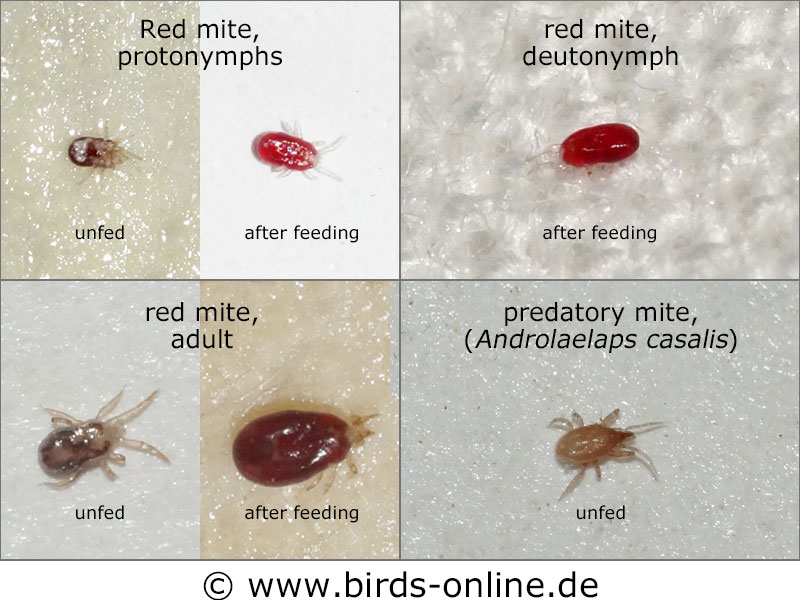Red mites are a common pest that can cause major issues for backyard chicken flocks and commercial poultry operations But identifying these tiny, elusive parasites can be tricky In this complete guide, we’ll cover everything you need to know about what red mites look like, where they hide, and how to spot an infestation.
What Are Red Mites?
Red mites, also known as chicken mites or roost mites, are a type of external parasite that feeds on the blood of chickens, turkeys, and other birds Their scientific name is Dermanyssus gallinae During the day, red mites hide in cracks and crevices around the coop. At night, they emerge to crawl onto sleeping chickens and take a blood meal.
Red Mite Appearance and Behavior
Adult red mites are very small, usually less than 1 mm in length. They have an oval body shape and 8 legs. After feeding, red mites appear reddish-brown due to ingesting blood. Unfed mites are more grey or yellowish in color. Red mites move slowly and deliberately, often traveling along perches and walls to reach their host. They tend to congregate in clusters around the vent, breast, legs, and underside of wings.
Red mites go through several life stages each with a slightly different appearance
- Eggs – Tiny, oval, translucent white, around 0.5 mm long
- Larvae – 6 legs, whitish-translucent, smallest mobile stage
- Nymphs – 8 legs, pale yellow-brown, larger with each molt
- Adults – 8 legs, red-brown after feeding, ~1 mm long
Where Do Red Mites Hide?
During the day, red mites conceal themselves in dark, humid areas inside the coop and around roosting areas. Common hiding spots include:
- Cracks and crevices in wood
- Undersides of perches
- Inside nesting boxes
- Under loose coop flooring
- In litter and bedding
- Behind feeders and waterers
Red mites can squeeze into extremely narrow spaces and cracks due to their flattened bodies. They prefer areas that are sheltered, warm, and close to the host birds.
How to Identify Red Mites
Checking for red mites takes patience and a close inspection. Here are some tips:
-
Inspect at night – Use a flashlight to check roosting birds when mites are active. Part feathers gently to view the skin.
-
Check perches – Wipe perches with a white cloth to look for red smears or moving mites.
-
Use traps – Place rolls of tape or cardboard inside PVC tubes under perches to capture mites.
-
Look for clusters – Scan for tiny moving dots clustered around vent, breast, and underside of wings.
-
Watch for symptoms – Note increased preening, weight loss, decreased egg production, lethargy.
A magnifying glass may be needed to distinguish the tiny, slow-moving mites. Repeated checks are needed since populations can fluctuate. Isolate and treat any infested birds immediately.
How to Distinguish from Other Pests
It’s important to accurately identify red mites versus other common pests:
- Northern fowl mites – Stay on birds 24/7 unlike red mites
- Lice – Tend to be larger and avoid light unlike red mites
- Fleas – Larger and can jump, not as slow-moving as red mites
- Bed bugs – Red mites have longer legs and different body shape
Examining the pests closely with a magnifying glass can help discern key differences in size, shape, and behavior. An integrated pest management approach is needed to control red mites while preventing other pests.
Take Action Against Red Mites
If you spot red mites in your coop, take immediate steps to eradicate them before they spread and impact flock health. Treatment methods include sprays, dusts, heating or freezing the coop, and addressing hiding spots. Prevent reinfestation by sealing cracks, removing roosts, keeping the coop clean, and quarantining new birds.
Catching and accurately identifying a red mite infestation early is crucial. By understanding what to look for, you can protect your flock from these voracious pests. Be vigilant and keep a close eye on your birds and coop to keep red mites from creeping back in!

Poultry Red Mite – Pesky Persistent Parasites
- Hens may avoid using the nest box or not go into the house at night if the coop is badly infested
- Grey dust similar to ash (mite faeces) around the crevices and under perches
- Active red mite inside or outside the house which glow in the light of a torch at night
- Birds are looking pale, jaundiced faces and wattles, and look anaemic
- Depressed birds, very lethargic, loss of weight
- Decreased egg production coupled with increased feed intake
- Dark dots and speckles on eggs – they may be blood spots or look closely you may see the speckles move!
- In extreme cases, feather loss and signs of dermatitis
- Never assume that red mites are the problem if you can’t find any physical signs of them at all – sometimes sick hens display similar symptoms, whatever the cause!
How I FINALLY Got Rid of Poultry Red Mite
FAQ
How do you know if you have red mites?
Red mites that have had a blood meal will show up as tiny red specks or cluster of red specks. Red mites that have not fed overnight are grey, almost dust-like and harder to spot.
What kills red mites instantly?
Are red mites harmful to humans?
While many red mites are harmless to humans, some, like the poultry red mite (Dermanyssus gallinae), can cause skin irritation and itching due to bites.
How do I get rid of little red mites?
If you spot mites in your home, the best way to get rid of them is to vacuum them up. Make sure to empty the vacuum away from buildings. Indoor pesticides are usually not needed. If the infestation is so bad that you feel you need it, choose a pesticide specifically for indoor use and specifically for mites.
